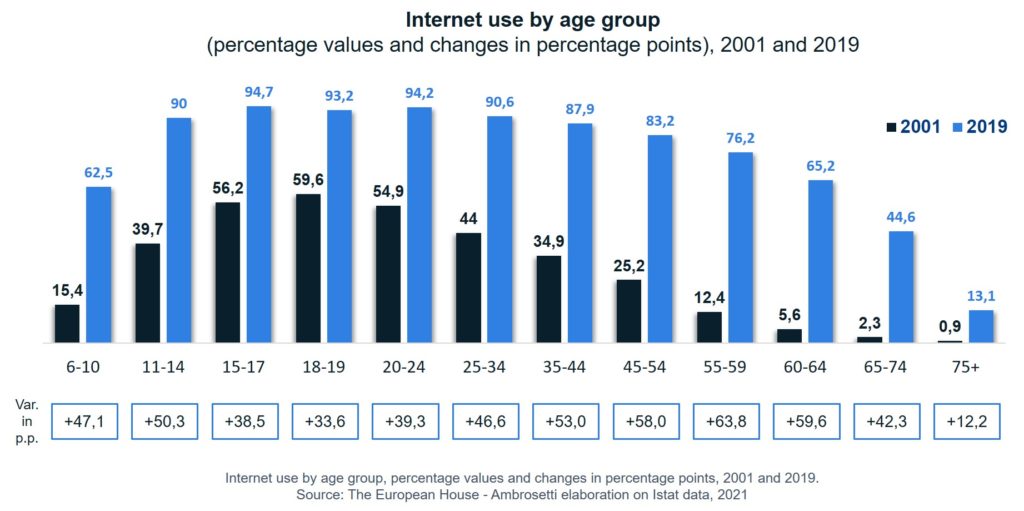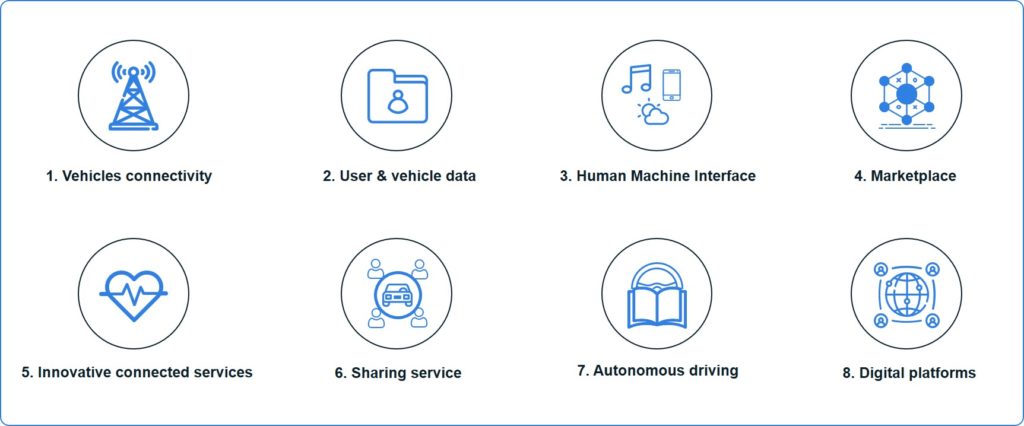
In the previous article – “The new mobility paradigm: not only new propulsion systems” – we described the vision of OCTO Telematics and The European House – Ambrosetti regarding the Connected Mobility model: a form of smart, connected and green mobility, in which vehicles are able to communicate with each other and with the surrounding ecosystem. The mobility of the future will make it possible to realise the concept of Vision Zero, outlined by OCTO Telematics, which envisages Zero Crash, Zero Pollution caused by means of transport and Zero Traffic in cities.
The mobility of the future will be based on new paradigms in line with the evolution of consumer needs and with the new technologies available on the market, two enabling factors for new business models and consumer services.
Consumer needs are constantly evolving and new consumption patterns, new lifestyles (increasingly connected) and greater attention to environmental sustainability issues are emerging. They are emerging hand in hand with the new generations: Millennials (1981-1996) and GenZ (>1997) have profoundly different characteristics and distinctive factors compared to Baby Boomers (1946-1964) and GenX (1965-1980). In particular, the younger generations seek new values in the use of mobility systems and means of transport, including: Enjoyment, having a pleasant and enjoyable mobility experience with the possibility to customise the content of infotainment systems; Accomplishment, increasing productivity and having the possibility to perform other tasks during travel and commuting; Well-being, increasing physical safety during travel, combined with the possibility to monitor the traveller’s health status; Social Connection, maintaining social relationships both in and out of the vehicle (e.g. trip sharing); Environmental consciousness, reducing environmental impacts by choosing optimal routes and managing the new needs arising from the spread of non-traditional powered vehicles (e.g. electric vehicles); Privacy, having certainty about the security of data originated during transport and personal data shared with the vehicle.
The generational evolution is accompanied by a change in the composition of society: in recent years there has been an increase in single people (33.4% of Italian households in 2018, +4.0 percentage points 2018 vs. 2008) and a decrease in couples with children (34.1% of Italian households, -5.0 percentage points 2018 vs. 2008). This change implies new needs and habits in the use of mobility services with a consequent rethinking of city management models, infrastructures and citizen services.
At the same time, Italian society is becoming increasingly digital and accustomed to the use of technological tools: in the last 20 years internet use has grown by an average of +45 percentage points and in 2020 over 50 million people used the internet daily; in fact, over 83% of the Italian population is connected. The emergence of models for using services via the internet (and smartphones) has led to new consumer experiences that are now sought after and requested by consumers when using other goods and/or services, forcing all industrial players to adapt; in this sense, it will become crucial to be able to create compelling and engaging experiences even when using a vehicle, whether it is owned, rented or shared.

Another emerging trend is the spread of IoT (Internet of Things) devices, corresponding to the emergence of an all-round connected lifestyle. The concept of ‘Connected Life‘ refers to a world in which our homes, jobs, cities and means of transport will be intrinsically connected thanks to the seamless use of different tools. The spread of IoT and Artificial Intelligence technologies will make everyday activities smarter. The combination of multiple devices interacting according to Machine-to-Machine (M2M) logic will create intelligent systems based on the integration of voice, video and data services to ensure connection anywhere and anytime.
Technology is the enabling factor in the transformation of traditional mobility towards a model in which it becomes increasingly connected, close to the needs of consumers and with a central role in the Smart Society. OCTO and The European House – Ambrosetti have identified eight technologies – Vehicle Connectivity, User & Vehicle Data, Human Machine Interface, Marketplace, Connected Services, Sharing service, Autonomous Driving and Digital Platforms – that will play a key role in the creation of a true Connected Mobility ecosystem.

Over the next 10 years, connectivity systems will become an increasingly integral part of vehicle design: by 2030 it is expected that more than 60% of vehicles on the road will be natively equipped with advanced connectivity systems. The increased possibility of connecting and exchanging information between vehicles will be driven by the spread of 5G technology, which will make it possible to speed up data exchange, reduce latency and maintain a greater number of connections, as well as allowing very high connection density, enabling new models of mobility management (e.g. fleets, infrastructure, etc.) and Smart City governance (e.g. traffic management). The result of increased vehicle connectivity will be the creation of mobility services that will be based on new data sources (not only data generated by the vehicle, but also data from the external environment, the driver, navigation systems and municipalities).
In this evolutionary framework, infotainment systems, which are already able to enable a two-way relationship between user and vehicle, play a key role. The next ten years will see an overall redesign of vehicle design around new infotainment tools. New screens, virtual assistants and integration with user devices will characterize this paradigm in order to offer a seamless experience – a user’s digital experience will be guaranteed regardless of the different devices used, inside and outside the vehicle. The new relationship between user and vehicle will allow companies to integrate new offers – which will enrich the user experience – inside the vehicle, according to a marketplace logic: buying and selling maintenance services, purchasing additional performance packages, comparing insurance prices, planning trips, sharing the vehicle, sharing long-distance trips, purchasing goods and services.
In addition, the ability of a vehicle to collect an increasing amount of data, while respecting privacy requirements, will allow third party actors to develop new services for the consumer. In this sense, the data collected can be exploited to develop new value offers for users, in a logic of transformation of the means of transport into a smart car, as happened with smartphones over a decade ago.
We must also consider the growing popularity of the sharing model, which implies a shift from a logic of ownership to a logic of vehicle use. Carsharing users worldwide increased by +24.1% from 2017 to 2020 – in the next five years a further +33.4% increase in users of sharing services is expected (2025 vs 2020). To date, there are more than 7,000 free-floating vehicles in Italy: of these about 1,250 are station-based, more than 2.5 million people are registered on the various platforms and 10 million rentals are made between Rome and Milan each year. Italy is the second country in Europe for car sharing services, after Germany: in 2020 the market consisted of 15 thousand vehicles for a turnover of 357 million Euros and in 2025 a market of 44 thousand vehicles and 725 million Euros is expected.
In the next 10 years, the number of self-driving cars of Level 3 or higher will increase
90-fold compared to 2020, surpassing 18 million annual sales. The self-driving vehicle will be less and less tied to the concept of ownership and will transform the current model of use: the use of a self-driving vehicle according to a ride-hailing logic can generate savings of more than 5,000 Euros/year compared to a model of vehicle ownership. Compared to more traditional models, sharing an autonomous vehicle allows to achieve important performances: reduce by -46.5% the total cost per km travelled; reduce by -46.3% the total cost of annual use of a vehicle; reduce by -80% harmful gas emissions by 2050; optimize the integration between LPT and sharing mobility. The speed of deployment of autonomous vehicles will depend on the presence of an adequately developed support infrastructure. It will be necessary to develop smart roads capable of communicating and exchanging data with vehicles in transit and a connected infrastructure system. Finally, support facilities and mobility hubs for recharging, maintaining and sanitizing shared vehicles will be needed.
The new mobility models will be based on platforms that will make it possible to optimize the management of cities and vehicle fleets. Regarding the first aspect, the platforms will enable the development of the Mobility-as-a-Service model: the platform aimed at the user of the mobility service will become a one-stop-shop for all the mobility needs of the individual, integrating micro-mobility systems, local public transport and individual mobility with shared vehicles. According to the same logic, digital platforms in the industrial sector will enable Connected Operations systems aimed at creating new business and operations management models with the main applications for fleet management and predictive maintenance.
Ultimately, it can be argued that the ability to use connected mobility and data to better meet customer needs unlocks new value for users, citizens and companies that is currently trapped and uncapturable by current business models. Value accumulates when technology makes it possible to provide customers with a better experience. The ability to unlock this new value will depend on the ability of companies to build innovative business ecosystems capable of exploiting this shift from product to data.
In the next article in this series, we will go into detail about the vision of mobility that is enabled by vehicle connectivity. This will be based on the insights and recommendations that emerged from three working groups that The European House-Ambrosetti and OCTO set up with the involvement of over thirty private and public stakeholders.
Authors:
Alessandro Viviani : Senior Consultant – Innotech Hub
Corrado Panzeri : Associate Partner – Head of InnoTech Hub
The European House – Ambrosetti